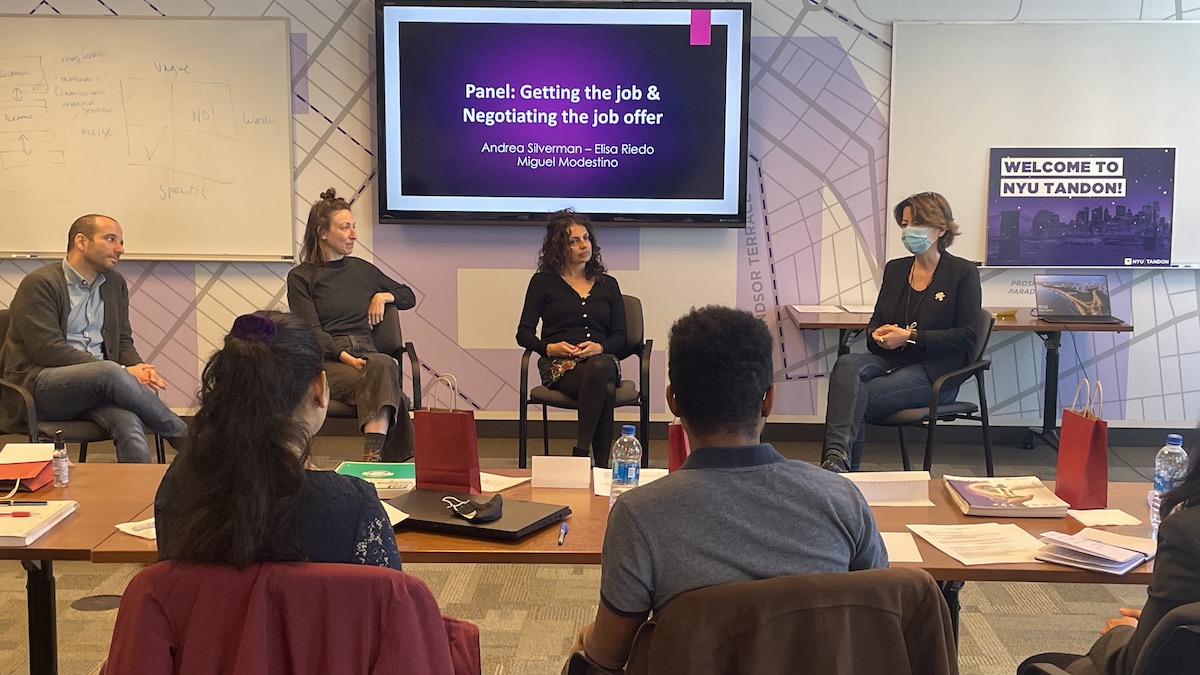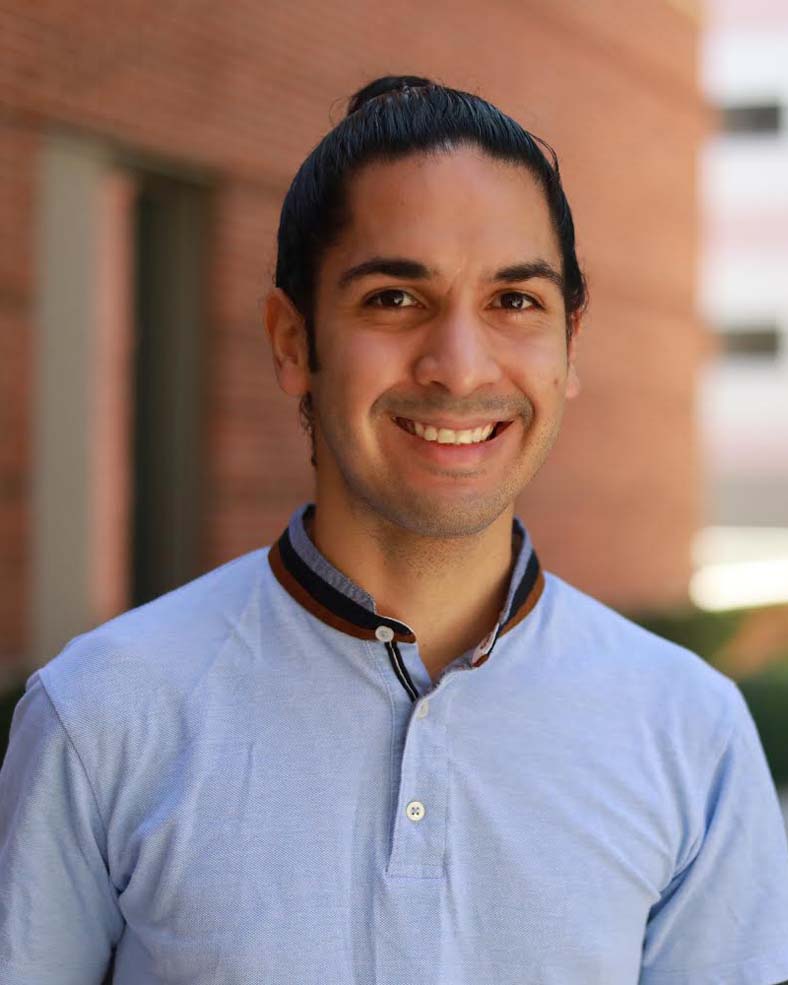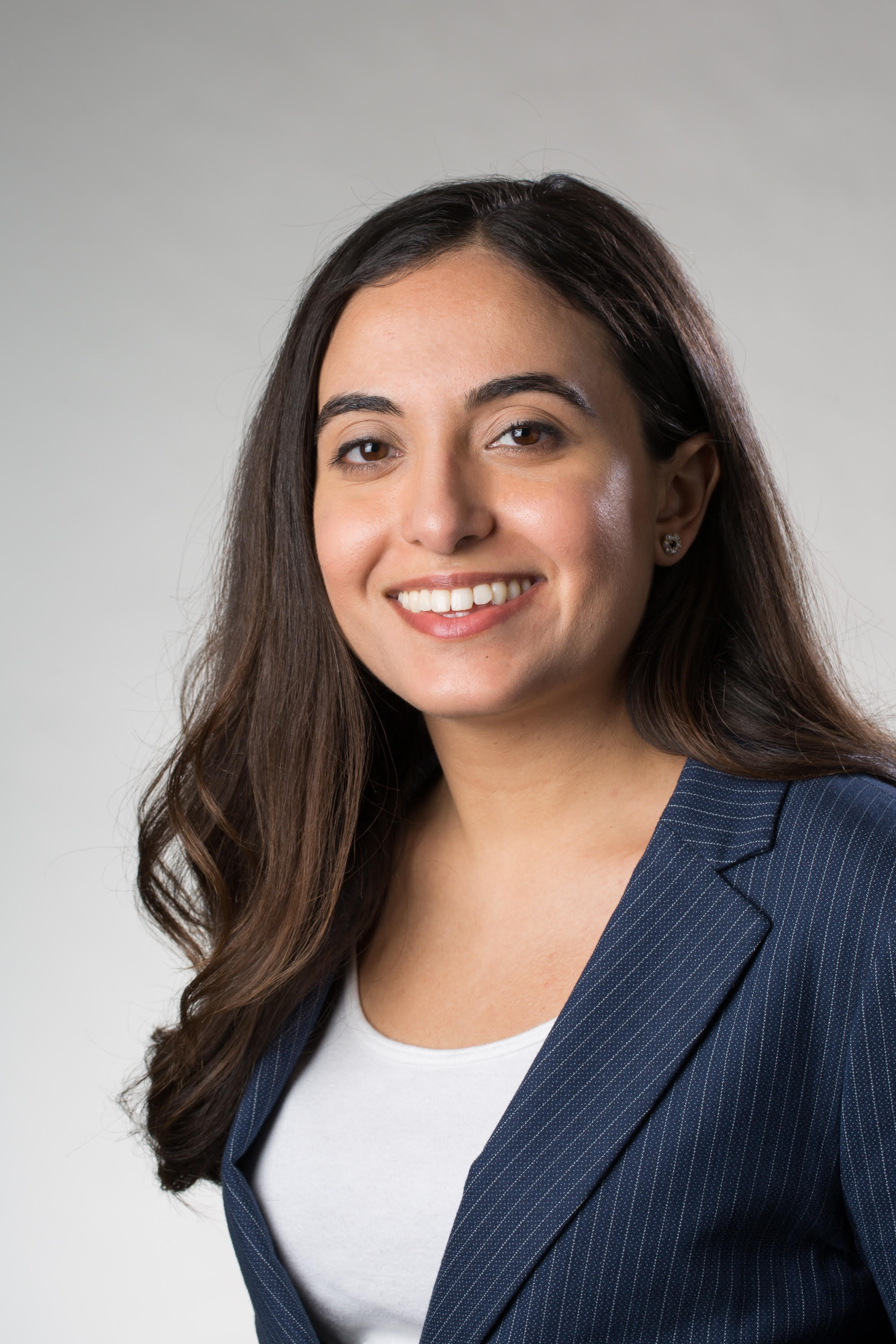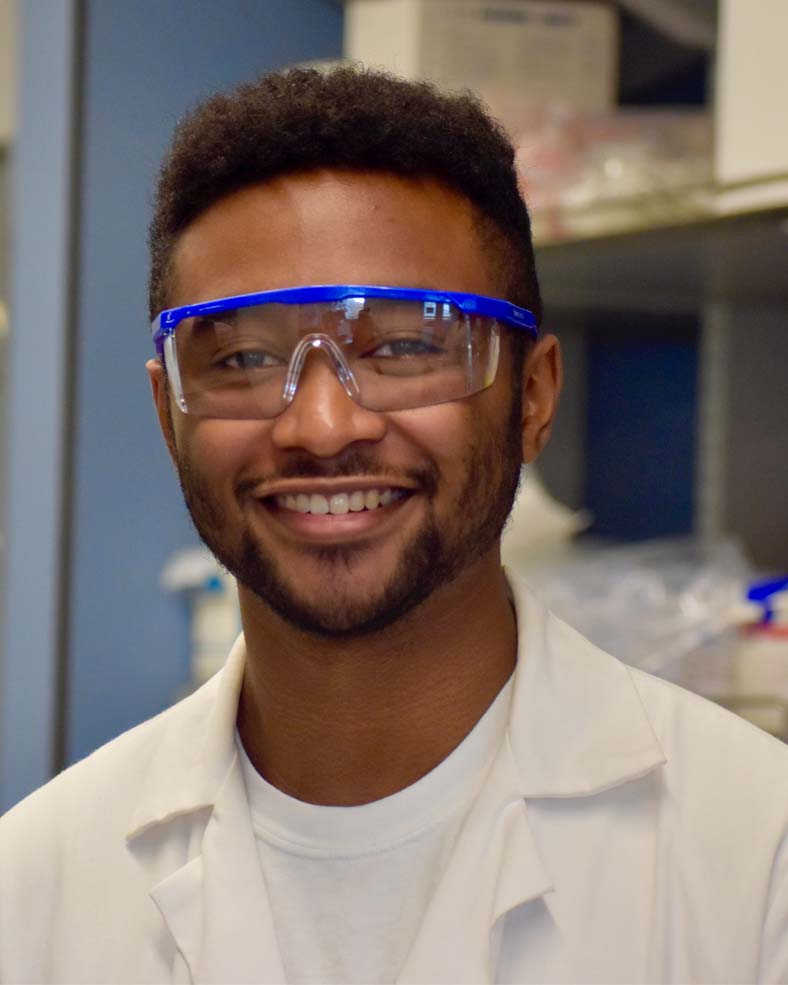The Faculty First Look initiative at NYU Tandon welcomes an accomplished, new cohort

The 2022 Faculty First Look cohort met at Tandon for two days of workshops, panels, and networking
The history of Faculty First Look
A few years ago, when Charlton McIlwain, then an associate dean at NYU Steinhardt, now vice provost for faculty engagement and development, realized that there was a distressing lack of diversity in the applicants for tenure-track positions, he brainstormed with a friend, Derrick Brown, a computer scientist and tech entrepreneur who had pioneered the idea of Black-related search engines and websites in the 1990s.
Brown put forth a possible solution. As a high school student in South Carolina, he had attended a summer course for gifted students in computer science and coding, and he was then recruited to participate in Clemson University’s Career Workshop, an initiative aimed at underrepresented students. Without that early support, Brown might never have gone on to complete his graduate studies at Georgia Tech — with “early” being the operative word. Maybe approaching underrepresented doctoral students before they had even considered applying for professorships could be a way to diversify the pool.
Thus, NYU’s university-wide “Faculty First Look” program was born: McIlwain had hoped to have 10 doctoral students apply for the initial cohort, so when more than 100 expressed interest, he knew he had hit upon something important.
Faculty First Look at Tandon
The program has been an unqualified success at NYU Tandon, given the school’s mission of paving a path to the STEM professions for all. Tandon Faculty First Look fellows now get feedback on their research and personalized guidance on the admittedly daunting job application process, which can involve formulating lengthy teaching and research statements, impressing committees, and navigating labyrinth requirements.
Last month, the newest Faculty First Look cohort arrived at Tandon for a jam-packed two days of workshops, panels, and networking — kicking off with a get-acquainted dinner and culminating with individualized feedback sessions.
Expert advice was on tap about everything from writing in the sciences and engineering to negotiating an academic job offer, and the participants, who ranged from early-stage Ph.D. candidates to post-docs, were all ears.
“We chose the members of the cohort based on their accomplishments,” Nathalie Felciai, NYU Tandon’s Senior Program Manager, Talent & Change Management, explained. “But they are so much more than their CVs. It’s incredible to contemplate the potential they represent, their capacity for transformative research, and their determination to make a positive impact on the world.”

2022 Faculty First Look Scholars
Haripriya Kannan

How did you become interested in STEM topics?
I grew up in Neyveli, a town in the Indian state of Tamil Nadu. It’s best-known for its reserves of a form of coal known as lignite. While growing up, I saw real-life applications of engineering concepts around the industrial area; at the same time, it was also hard not to miss how crucial sustainable energy was for a better environment and health. I started moving towards the discipline of materials engineering, which would allow me to explore research in the energy and health sectors. Later, research internships at the Indian Institute of Technology-Madras, India, and RWTH-Aachen, Germany, during my undergraduate years guided me towards Ph.D. studies. These opportunities created a space for me to meet senior students, women scholars, and students from diverse backgrounds, and discuss various intriguing topics that imbued me with curiosity and enthusiasm.
Describe your academic journey and research up until now.
I was one of the few girls from my hometown to pass a competitive exam and was ultimately accepted to the National Institute of Technology, in Trichy.
In 2017 I earned my undergraduate degree in Metallurgical and Materials Engineering with research internships at some of the top institutes in India and Germany. Later, I chose to come to NYU Tandon, and I’ve been working in Dr. Ayaskanta Sahu’s Hybrid Nanomaterials Lab in the Chemical and Biomolecular Engineering Department. Our group researches quantum dots and perovskites, a new class of material for efficient energy conversion, and my research involves using these materials in the design of next-generation X-ray detectors, with a focus on early-stage cancer detection. (While pursuing my doctoral research, I also earned my master’s degree in chemistry in 2020.)
How do you feel about participating in the Faculty First Look program?
The program gave me the opportunity to go through the different stages of the application process with experts, from writing to giving a job talk. The feedback I received gave me stepping stones to work on. I interacted one-on-one with professors I admire throughout the day and got to hear about their academic journeys. The program showed me some crucial details in effectively crafting an application.
It was encouraging to hear that it is okay if your first application for a faculty position isn’t successful, and most importantly, I got to hear how it could be worked on further if that happens. The program was very well-planned and executed, and it definitely enriched my confidence that I could reach my goals. The environment was supportive, and I met students and postdoctoral researchers with similar goals and formed a great network. At the end of the day, it prepared me to a great extent, and it was all that I was looking for in a program designed for career advancement.
What are your ultimate goals?
I’d like to return to India to pursue an academic position at one of the top research institutes. And, of course, I’d like to further my work on quantum dots and perovskites for photonics applications.
Juan Carlos Vega-Vila

How did you become interested in STEM topics?
I had always loved math, and in eighth grade, I took a class that sparked my interest in chemistry. Chemical engineering seemed like the natural fit.
Describe your academic journey and research up until now.
As a 14-year-old growing up in Puerto Rico, I won admission to the Centro Residencial de Oportunidades Educativas de Mayagüez (CROEM), a boarding school specializing in math and science. My parents were initially worried because it was located on the western coast of the island, far from my native town, but they were also excited and supportive throughout the entire process. They realized that no other high school in Puerto Rico would give me the opportunities I would have at CROEM.
As it turns out, I didn’t return to my hometown; I remained in Mayagüez and earned a B.S. in chemical engineering, magna cum laude, from the University of Puerto Rico in 2014. My professors’ academic “family trees” extended to numerous other universities, and they encouraged me to come to the U.S. to continue my education and advance my research into zeolites, which are microporous aluminosilicates used as catalysts.
In 2019 I earned my Ph.D. in chemical engineering from Purdue University, and I was subsequently recruited by UCLA to conduct postdoctoral research. That’s where I am currently, and I’m engaged in investigating the influence of temperature, duration of the hydrothermal treatment, water content, pH, and other synthesis conditions on the precipitation of silicate hydrates, which can enhance the strength and flexibility of industrial materials like cement.
How do you feel about participating in the Faculty First Look program?
I traveled all the way across the country to attend the Faculty First Look event that was recently held, and I can say emphatically that it was worth every mile. Every component, from the welcome dinner to the writing workshop, was extremely well-thought-out, and it was an honor to get the perspective of Tandon faculty members like Professor Elisa Riedo and Professor Miguel Modestino.
What are your ultimate goals?
I’m excited about both research and teaching, and an academic position would allow me to do both.
Imara Mohamed Nazar
How did you become interested in STEM topics?
I had a wonderful role model, because my mother is a science teacher back in Sri Lanka.
Describe your academic journey and research up until now.
I earned my undergraduate degree in electrical and electronics engineering at the University of Peradeniya, which is considered to be the top institution of higher learning in Sri Lanka. When it was time to consider graduate school, however, I wanted to study in the U.S., and my professors agreed that I would gain a lot from the experience.
I’m now at the State University of New York, in Albany, earning my Ph.D. and working on new ways to detect radio frequency interference. People think right away about cell phone reception, but it goes well beyond that. If the satellites gathering weather data experience interference, for example, that can affect the study of climate change and even industries like agriculture, which depends on that data for crop planting schedules.
How do you feel about participating in the Faculty First Look program?
I think of the experience as a much needed and appreciated guidebook. I’ve never received such personalized advice before. The next year is going to be crucial for me, and knowing where I need to improve and the areas I should be focused on is invaluable.
What are your ultimate goals?
In order to grow professionally, I’ll need to stay in the U.S. Sri Lanka has wonderful universities, and I was privileged to serve as a lecturer at the Sri Lanka Institute of Information Technology, but there are few opportunities to conduct in-depth research there.
Diana Mojahed

How did you become interested in STEM topics?
My aunt ran a phlebotomy lab, and visiting her as a child was a fascinating experience. That inspired my interest in science and medicine.
Describe your academic journey and research up until now.
I’m a native of Lexington, Massachusetts, and I had been interested in attending Tufts, which has a beautiful campus right near there. I majored in Biology and minored in Physics, and was fortunate to have the opportunity to do research at the Wellman Center for Photomedicine at Massachusetts General Hospital, developing new types of microscopes in the Tearney Lab. I graduated in 2016, with an undergraduate thesis titled, “Live Cell Phase Imaging under Whole Blood Shear Flow Using Oblique Back-Illumination.”
At Mass General, I had discovered how much I like to build things, so Biomedical Engineering seemed like a logical step. In 2021 I earned a doctoral degree in that discipline from Columbia University, and my advisor was Professor Christine Hendon. My lab was in the Department of Electrical Engineering, and I was exposed to immense knowledge and excellent classes that helped propel my research and academic training. I think there’s a lot of benefit from immersing yourself in different departments and expanding your boundaries.
My Ph.D. is the best thing that has happened to me so far in my life — I grew and accomplished a lot during those years. I designed and built an ultrahigh-speed optical coherence tomography (UHS-OCT) system on a medical device cart for breast cancer imaging applications — developing fully customized and easy-to-use software, hardware, and computer-controlled optics — and I subsequently conducted a clinical study with 100 patients. I also developed custom convolutional neural network (CNN) algorithms to classify disease in OCT images, and I hope that contributes to the speed at which biopsies can be evaluated because the waiting time for results is always nerve-wracking for patients.
Additionally, I collaborated with the Lipson Nanophotonics Group to integrate a millimeter-scale silicon nitride chip-based supercontinuum light source with OCT, with the goal of miniaturizing imaging systems significantly. That research led to me being the first author on a paper published in Science Advances. I recently started as a Postdoctoral Associate at the Massachusetts Institute of Technology in the Department of Materials Science and Engineering working with Professor Juejun (JJ) Hu, and I’m very excited to see what I can accomplish there.
How do you feel about participating in the Faculty First Look program?
The whole thing was amazing. As I sat at the Welcome Dinner on the first night, I looked to the left and right of me, and on each side was a professor happy to get to know me and to give personalized advice based on their own extensive experience. I particularly welcomed the chance to give my faculty job presentation the next day; that type of practice is invaluable.
What are your ultimate goals?
My dream is to continue to develop new medical diagnostic tools and contribute to better patient outcomes.
Parker Lewis

How did you become interested in STEM topics?
It seems to run in the family; my mother is a doctor, and my father is a respiratory therapist. The decision to pursue research that would have important clinical applications was cemented for me during my freshman year at Princeton, when my mother was diagnosed with cancer. She passed away during my senior year.
Describe your academic journey and research up until now.
"At Princeton, I majored in Chemical and Biological Engineering, and I earned my bachelor’s degree in 2020. I came to NYU Tandon for my doctoral studies because I wanted to work with Nathalie Pinkerton, whose research group is developing responsive soft materials for drug delivery applications. I’m working with nanoparticles that release therapeutic drugs into the body only where and when they are needed. To explain in simple terms, when you have a headache and you take a drug like acetaminophen, it goes where it needs to go to treat the pain in your head, but it also circulates everywhere else in your body. That’s not a big deal in that case, but when you’re treating a disease like cancer, the drugs required to kill cancer cells are toxic to other cells too, so you really don’t want them harming healthy cells. Targeted drug delivery is safer and more efficient."
How do you feel about participating in the Faculty First Look program?
I learned so much, but one of my major takeaways is that when presenting yourself in person or in writing, it’s not enough to simply describe your research and list your accomplishments. You have to also convey your values and explain why your work is so important to you.
What are your ultimate goals?
I plan to stay in academia, continue to conduct research aimed at benefiting the world, and, hopefully, have the opportunity to mentor others with similar goals.
Yamuna Phal

How did you become interested in STEM topics?
When we were small, my brother and I spent a lot of time reverse-engineering the remote controls, radios, and other electronics in our house. You could say we were partners in crime! He is also in a STEM field now, so we sometimes joke that we have each other to blame.
Describe your academic journey and research up until now.
In India, I scored in the top 1 percent of the college entrance exams, so I was admitted to the Indian Institute of Technology, in Roorkee, which is a very good school. Many people in India consider careers in engineering, so getting into a top school is very competitive. I am a competitive person, so I didn’t mind that. At Roorkee, I ran 400- and 800-meter races, and I ended up becoming the captain of the school’s track and field team and heading a league in which the IITs compete — similar in a way to the NCAA in America.
After graduating, many of my classmates headed to consultancies or the financial industry, but I wanted to stick with engineering. I got a job as a failure analyst at a tech firm, which stationed me in Malaysia, but I knew if I wanted to advance I better consider graduate school.
I was specifically interested in hardware electronics for space exploration applications, and Caltech in Pasadena has a long history of accomplishment in that area, so in 2012 I came to the U.S. and earned my master’s degree there. While at Caltech, I also worked with JPL briefly, and that was a dream come true! My experience as an engineer with the Swedish Institute of Space Physics, under the European Space Agency (ESA), introduced me to a whole new field of analog design. I joined Professor Bhargava’s research group at the University of Illinois, Urbana-Champaign, for pursuing my Ph.D. in Electrical & Computer Engineering to develop next-generation IR imaging instruments. Using my expertise in spectroscopic imaging for remote sensing applications I now seek to develop novel cancer imaging technology.
How do you feel about participating in the Faculty First Look program?
I have taken part in a lot of career development programs but Faculty First Look was truly unique. It wasn’t just someone standing in front of the room giving one-size-fits-all advice. The Tandon faculty members really made an attempt to get to know us and tailor their recommendations to our strengths and goals. I felt particularly gratified to get the chance to know Professor Elisa Riedo, because she worked in industry before joining academia. And I could relate to that path. It's truly inspiring and encouraging to connect with a woman professor in STEM, who is also an inventor developing innovative technology.
What are your ultimate goals?
I enjoyed working in industry but I love teaching and interacting with students, so I do want to remain in academia. I would like to give students the benefit of my experience and help guide them the way my mentors have done for me. Besides that, it’s fun to get people excited about learning and doing hands-on labs, and who doesn’t want a fun job?

Several esteemed Tandon faculty members took the time to interact with and advise the members of the cohort, including:
- Eray Aydil, Chair of the Chemical and Biomolecular Engineering
- Andreas Hielscher, Chair of the Biomedical Engineering Department
- Rastislav Levicky, Professor of Chemical and Biomolecular Engineering
- Miguel Modestino, Associate Professor of Chemical and Biomolecular Engineering
- Maurizio Porfiri, Professor of Mechanical & Aerospace Engineering and Director of CUSP
- Elisa Riedo, Director of Faculty Development and Professor of Chemical and Biomolecular Engineering
- Ludovic Righetti. Associate Professor of Electrical and Computer Engineering
- Andrea Silverman, Assistant Professor of Civil and Urban Engineering
- Yao Wang, Associate Dean for Faculty Affairs and Professor of Electrical and Computer Engineering
Felciai points out that convening a program as multifaceted as Faculty First Look requires hard work and various skillsets. “In addition to our Tandon faculty members and NYU writing instructors Abby Rabinowitz & Jonathan Mischkot, we had Phd student Dustin Britton and Postdoctoral Research Associate Jason Alexander Röhr pitching in,” she said, “and we could not have managed without the organizational help of Tandon staff members Hashem Nasralla and Molly Burns.”




